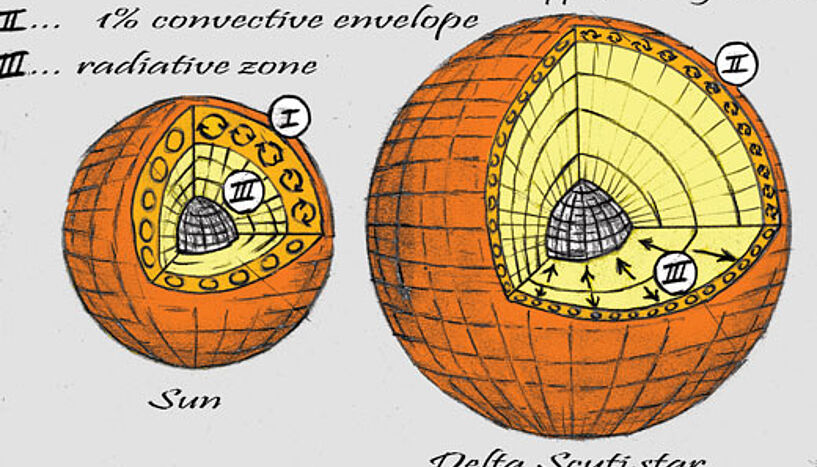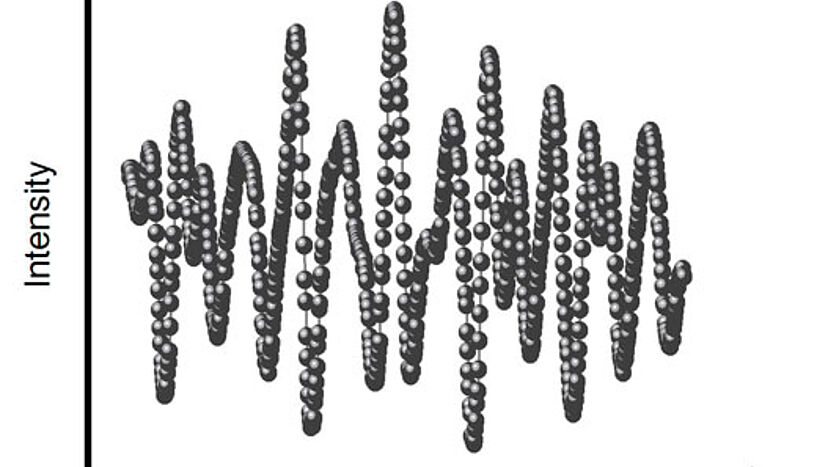The turbulent lives of stars
14. September 2011The stars are boiling! The reason is the energy generated in the center of the star that wants to escape. If this does not happen quickly enough, the star starts to ‘boil’ in the outer layers causing vibrations that result in light variations, like in the Sun. Such oscillations have now been discovered by Victoria Antoci and collaborators using the NASA spacecraft Kepler, but in a much hotter star. The scientists publish this in the most recent issue of “Nature”.
Besides the discovery of earth-like planets, astronomy is concerned with research on stellar oscillations, among many other topics. The vibrations cause periodic brightness variations of some stars. Asteroseismology works just like the seismic exploration of the Earth’s interior: the frequencies of seismic waves depend on mass and composition of a body and therefore allow to tomographically reproduce its interior structure.
What causes stellar oscillations?
Several mechanisms maintain periodic oscillations in stars. In the Sun it is “seething” (convection) in the outer layers, comparable with boiling water and the consequent audible sound of the pot. In stars with masses some 1.5 times solar and more it is the so-called “kappa mechanism” that excites periodic pulsations. “This process works like a heat or Diesel engine” explains Victoria Antoci from the Institute of Astronomy at the University of Vienna.
Stellar structure
Because of decades of research on solar oscillations it is known that the energy in the outer 30 per cent of the solar radius is transported by convection and below that, energy is transported by radiation.
In stars twice as massive, only one per cent of the envelope is convective. Also in this case, the energy generated in the core is transported by radiation. Stars with even higher mass should no longer possess a convective envelope. However, where exactly it disappears is unknown because of the extreme physical conditions in this domain.
One possibility to explore this is asteroseismology of so-called Delta Scuti stars. These stars are in the mass range where the convective envelope disappears. Delta Scuti stars show periodic light variations due to pulsations excited by the kappa mechanism. “Since more than ten years, scientists predicted that despite the small depth (one per cent) of the convective envelope of Delta Scuti stars convection should have sufficient energy to excite solar-like pulsations as well. Finally we succeeded to prove this”, Victoria Antoci is pleased.
„Kepler“ confirms the theory
In the framework of her PhD thesis the scientist examined hundreds of stars observed with NASA’s Kepler space telescope for solar-like oscillations and made a detection: the Delta Scuti star called HD 187547 is the first representative of the group showing both types of oscillations. “With HD 187547 we found the ideal object to study different processes and their interaction under extreme physical conditions” says Gerald Handler from Nicolaus Copernicus Center in Warsaw, the advisor of Victoria Antoci’s dissertation.
Statements about the actual depth of the outer convective layer are possible for the first time thanks to the work published in “Nature”, as is a calibration of convection models in this temperature domain. In addition, the presence of two different types of stellar oscillations permits to model the interior structure of HD 187547 with unprecedented precision. The scientists also determined that HD 187547 has unusual abundances of certain chemical elements on its surface, most probably a consequence of slow stellar rotation. Heavy elements dwindle down and become less abundant in the star’s spectrum (only the stellar surface is directly observable). On the other hand, light elements are pushed upwards and appear more abundant. This physical process is known as diffusion and is not fully understood in stars such as HD 187547.
Publication
The excitation of solar-like oscillations in a Sct star by efficient envelope convection
V. Antoci, G. Handler, T. L. Campante, A. O. Thygesen, A. Moya, T., Kallinger, D. Stello, A. Grigahcene, H. Kjeldsen, T. R. Bedding, T. Lüftinger, J. Christensen-Dalsgaard, G. Catanzaro, A. Frasca, P. De Cat, K. Uytterhoeven, H. Bruntt, G. Houdek, D. W. Kurtz, P. Lenz, A. Kaiser, J. Van Cleve, C. Allen & B. D. Clarke. In: Nature, September 14, 2011.
DOI:10.1038/nature10389.
Abstract
Scientific contact
Victoria Antoci
Institute of Astronomy
University of Vienna
1180 Vienna, Türkenschanzstraße 17
T +43-1-4277-518 22 ![]() victoria.antoci(at)univie.ac.at
victoria.antoci(at)univie.ac.at
Queries
Alexander Dworzak
Public Relations
University of Vienna
1010 Vienna, Dr.-Karl-Lueger-Ring 1
T +43-1-4277-175 31
M +43-664-602 77-175 31![]() alexander.dworzak(at)univie.ac.at
alexander.dworzak(at)univie.ac.at
Wissenschaftlicher Kontakt
Mag.a Victoria Antoci
Institut für AstronomieUniversität Wien
1180 - Wien, Türkenschanzstraße 17
+43-1-4277-518 22
victoria.antoci@univie.ac.at
Rückfragehinweis
Mag. Alexander Dworzak
ÖffentlichkeitsarbeitUniversität Wien
1010 - Wien, Universitätsring 1
+43-1-4277-175 31
+43-664-602 77-175 31
alexander.dworzak@univie.ac.at
Downloads:
Stellarstructure.jpg
Dateigröße: 1,25 MB
Lightcurve.JPG
Dateigröße: 406,59 KB


